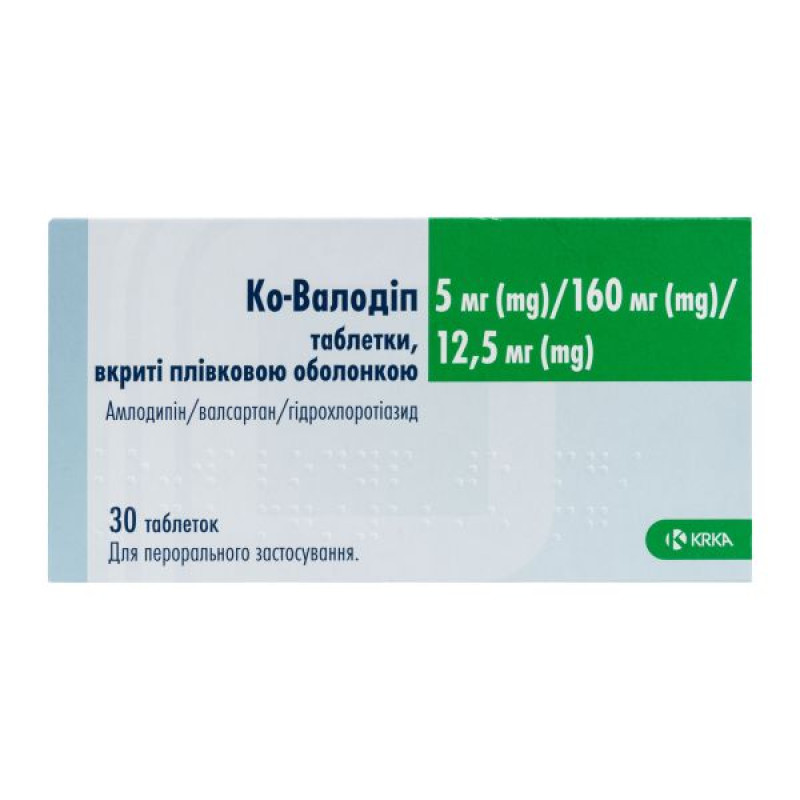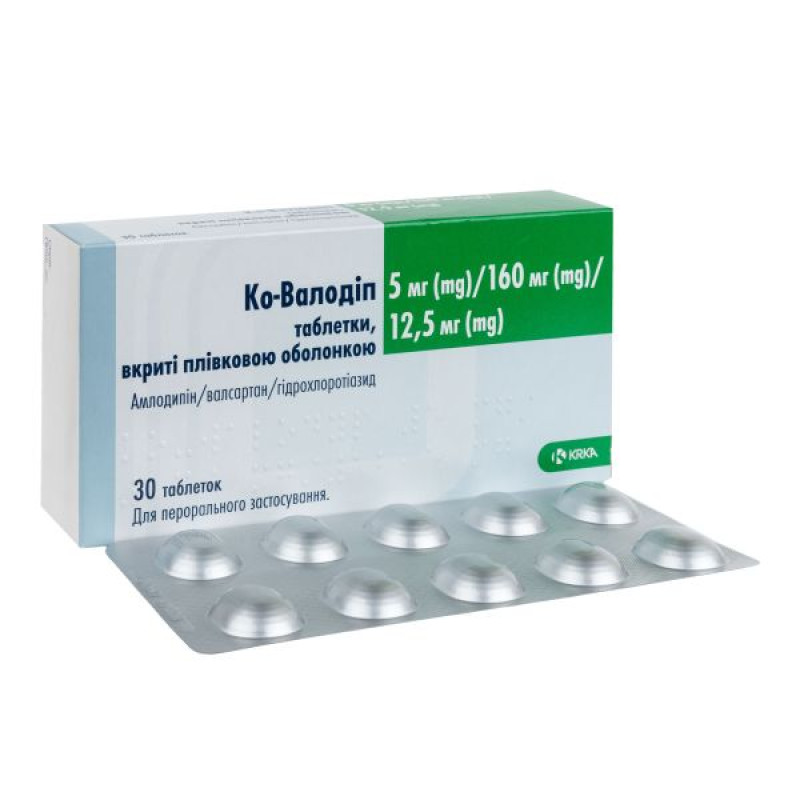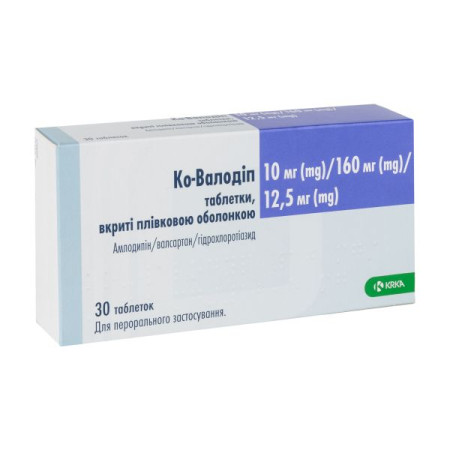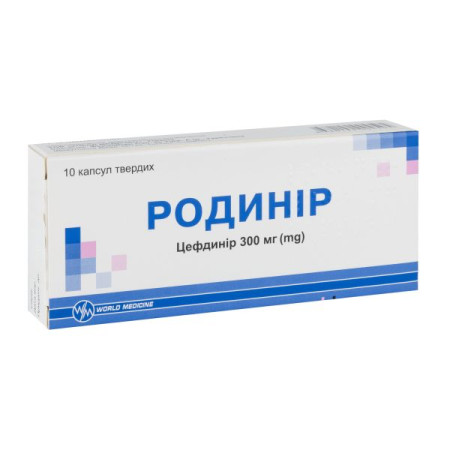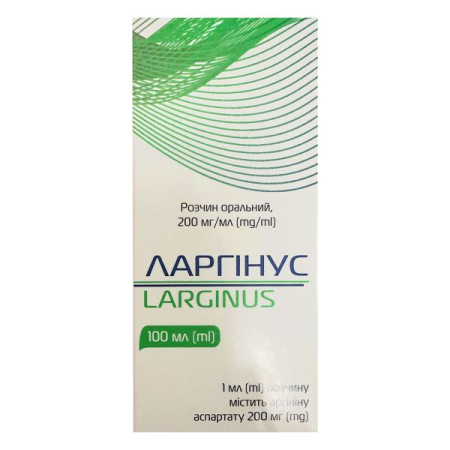Co-valodip tablets 5 mg + 160 mg + 12.5 mg No. 30
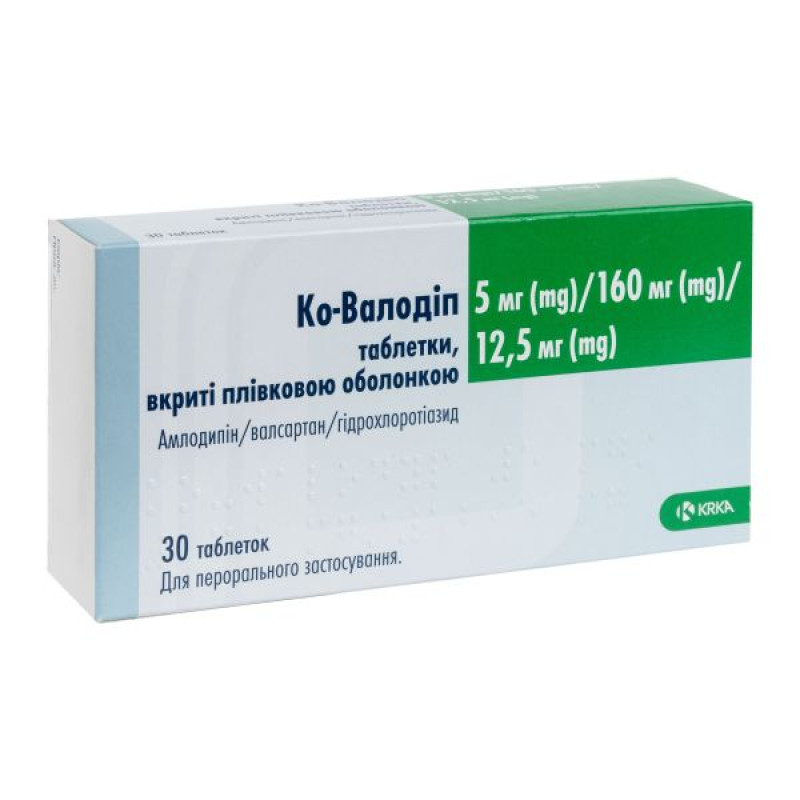
Instructions for Co-valodip tablets 5 mg + 160 mg + 12.5 mg No. 30
Composition
active ingredient: amlodipine in the form of amlodipine besylate, valsartan, hydrochlorothiazide;
1 film-coated tablet contains 5 mg amlodipine as amlodipine besylate, 160 mg valsartan and 12.5 mg hydrochlorothiazide or 10 mg amlodipine as amlodipine besylate, 160 mg valsartan and 12.5 mg hydrochlorothiazide, or 10 mg amlodipine as amlodipine besylate, 160 mg valsartan and 25 mg hydrochlorothiazide;
excipients: microcrystalline cellulose (type 200), mannitol, magnesium stearate, croscarmellose sodium, povidone K 25, colloidal anhydrous silicon dioxide, sodium lauryl sulfate;
film coating: polyvinyl alcohol, macrogol 3350, titanium dioxide (E 171), talc, yellow iron oxide (E 172) (only for dosage 10 mg/160 mg/25 mg), red iron oxide (E 172) (only for dosage 10 mg/160 mg/12.5 mg).
Dosage form
Film-coated tablets.
Main physicochemical properties:
Co-Valodip, film-coated tablets, 5 mg/160 mg/12.5 mg: white or almost white, oval, biconvex, film-coated tablets, engraved with K1 on one side;
Co-Valodip, film-coated tablets, 10 mg/160 mg/12.5 mg: pink oval biconvex film-coated tablets, engraved with K2 on one side;
Co-Valodip, film-coated tablets, 10 mg/160 mg/25 mg: brownish-yellow oval biconvex film-coated tablets, engraved with K4 on one side.
Pharmacotherapeutic group
Angiotensin II antagonists, other combinations. Valsartan, amlodipine and hydrochlorothiazide.
ATX code C09D X01.
Pharmacological properties
Pharmacodynamics.
Co-Valodip contains 3 antihypertensive agents with complementary mechanisms of blood pressure control in patients with essential hypertension: amlodipine belongs to the class of calcium antagonists, valsartan to the class of angiotensin II antagonists, and hydrochlorothiazide to the class of thiazide diuretics. The combination of these three components is characterized by a complementary antihypertensive effect.
Amlodipine
Amlodipine, which is part of Co-Valodip, inhibits the transmembrane entry of calcium ions into the heart muscle and vascular smooth muscle. The mechanism of antihypertensive action of amlodipine occurs through a direct relaxing effect on vascular smooth muscle, causing a decrease in peripheral vascular resistance and blood pressure.
Experimental data confirm that amlodipine binds to dihydropyridine and non-hydropyridine binding sites. Contractility of cardiac muscle and vascular smooth muscle depends on the passage of extracellular calcium into these cells through specific ion channels. Amlodipine at therapeutic doses in patients with arterial hypertension causes vasodilation, which leads to a decrease in blood pressure in the supine and standing positions. This decrease in blood pressure is not accompanied by pronounced changes in heart rate or plasma catecholamine levels with prolonged use.
Plasma concentrations correlate with effect in both young and elderly patients.
In patients with arterial hypertension and normal renal function, amlodipine in therapeutic doses leads to a decrease in renal vascular resistance and an increase in glomerular filtration rate and effective renal plasma flow without changing the filtration fraction or proteinuria.
As with other calcium channel blockers, hemodynamic measurements of cardiac function at rest and during exercise in patients with normal ventricular function treated with amlodipine generally showed a small increase in cardiac index without significant effects on dP/dt and on left ventricular and diastolic pressure or volume. In hemodynamic studies, amlodipine did not produce a negative inotropic effect in intact animals or humans at therapeutic doses, even when administered concomitantly to humans with beta-blockers.
Amlodipine does not alter sinoatrial node function or atrioventricular conduction in healthy animals or humans. In clinical studies in which amlodipine was used in combination with beta-blockers in patients with hypertension or angina, no changes in electrocardiogram parameters were noted.
Positive clinical effects of amlodipine have been observed in patients with chronic stable angina, vasospastic angina, and angiographically confirmed coronary artery disease.
Valsartan
Valsartan is an orally active, potent and specific angiotensin II receptor antagonist (ARB). Valsartan acts selectively on the AT1 receptor subtype, which is responsible for the known effects of angiotensin II.
In most patients, after oral administration of a single dose, the onset of the hypotensive effect occurs within 2 hours, and the maximum reduction in blood pressure is achieved within 4-6 hours. The antihypertensive effect lasts for 24 hours after administration of the drug. With repeated administration, the maximum reduction in blood pressure (with all dosage regimens) is usually achieved within 2-4 weeks.
Hydrochlorothiazide
The site of action of thiazide diuretics is mainly the distal convoluted tubules of the kidneys. It has been confirmed that there are high-affinity receptors in the renal cortex, which are the main binding site for thiazide diuretics and inhibit NaCl transport into the distal convoluted tubules. The mechanism of action of thiazides is to inhibit Na+Cl– transporters, possibly by competing for Cl– sites, which in turn affects the mechanisms of electrolyte reabsorption: directly increases the excretion of sodium and chlorine to an approximately equivalent extent and indirectly, due to the diuretic effect, reduces plasma volume with subsequent increases in plasma renin activity, aldosterone secretion and urinary potassium excretion, as well as a decrease in serum potassium.
Pharmacokinetics.
Linearity
Amlodipine, valsartan and hydrochlorothiazide exhibit linear pharmacokinetics.
Amlodipine/valsartan/hydrochlorothiazide
After oral administration of the combination of amlodipine/valsartan/hydrochlorothiazide to healthy adult volunteers, peak plasma concentrations were reached within 6-8 hours, 3 hours and 2 hours, respectively. The rate and extent of absorption of amlodipine, valsartan and hydrochlorothiazide from the combination product are similar to those observed when the components are administered as separate agents.
Amlodipine
Absorption: After oral administration of therapeutic doses of amlodipine alone, peak plasma concentrations were reached within 6–12 hours. Absolute bioavailability ranged from 64% to 80%. Food intake did not affect the bioavailability of amlodipine.
Distribution: The volume of distribution is approximately 21 L/kg. In vitro studies of amlodipine have shown that approximately 97.5% of the drug in circulating blood is bound to plasma proteins.
Biotransformation: Amlodipine is extensively (approximately 90%) metabolized in the liver to inactive metabolites.
Elimination: Amlodipine is eliminated from plasma in two phases, with a terminal half-life of approximately 30–50 hours. Steady-state plasma levels are reached after 7–8 days of continuous dosing. 10% of the parent amlodipine and 60% of the metabolites of amlodipine are excreted in the urine.
Valsartan
Absorption. After oral administration of valsartan alone, peak concentrations are reached within 2–4 hours. The mean absolute bioavailability is 23%. Food intake reduces exposure (as determined by AUC) to valsartan by approximately 40% and the maximum plasma concentration (Cmax) by approximately 50%, although approximately 8 hours after administration, valsartan concentrations are similar in the fasted and fed groups. However, this decrease in AUC is not accompanied by a clinically significant reduction in therapeutic effect, and valsartan can be administered without regard to food intake.
Distribution: The volume of distribution of valsartan at steady state after intravenous administration is approximately 17 liters, indicating that valsartan is not extensively distributed. Valsartan is extensively bound to serum proteins (94–97%), mainly to serum albumin.
Biotransformation: Valsartan is not significantly transformed, with only approximately
20% of the dose is excreted as metabolites. A hydroxymetabolite has been identified in plasma at low concentrations (less than 10% of the AUC of valsartan). This metabolite is pharmacologically inactive.
Elimination: Valsartan is excreted primarily in the feces (approximately 83% of the dose) and urine (approximately 13% of the dose), mainly as unchanged drug. After intravenous administration, plasma clearance of valsartan is about 2 l/h and renal clearance is 0.62 l/h (approximately 30% of total clearance). The elimination half-life of valsartan is 6 hours.
Hydrochlorothiazide
Absorption. Hydrochlorothiazide is rapidly absorbed after oral administration (Tmax approximately 2 hours). The increase in mean AUC is linear and dose-proportional over the therapeutic dose range. The effect of food on the absorption of hydrochlorothiazide, if any, is clinically insignificant. The absolute bioavailability of hydrochlorothiazide is 70% after oral administration.
Distribution: The apparent volume of distribution is 4–8 L/kg. Hydrochlorothiazide in the circulating blood is bound to plasma proteins (40–70%), mainly serum albumin. Hydrochlorothiazide also accumulates in erythrocytes in amounts approximately three times higher than plasma levels.
Elimination: Hydrochlorothiazide is eliminated from plasma with a terminal elimination half-life of 6 to 15 hours. There is no change in the kinetics of hydrochlorothiazide with repeated dosing, and accumulation is minimal with once-daily dosing. More than 95% of the absorbed dose is excreted unchanged in the urine. Renal clearance consists of passive filtration and active tubular secretion.
Certain patient groups
Children (under 18 years of age)
There are no pharmacokinetic data in children.
Elderly patients (aged 65 years and over)
The time to reach Cmax of amlodipine is similar in young and elderly patients. In elderly patients, the clearance of amlodipine tends to decrease, resulting in an increase in the area under the curve (AUC) and half-life. The mean systemic AUC of valsartan is 70% higher in elderly patients than in younger patients, so caution should be exercised when increasing the dose in such patients.
Systemic exposure to valsartan is slightly higher in elderly patients compared to younger patients, but this is not clinically relevant.
Limited data indicate that the systemic clearance of hydrochlorothiazide is reduced in both healthy elderly volunteers and elderly patients with hypertension compared to younger healthy volunteers.
Since the three components of the drug are equally well tolerated by young and elderly patients, the usual dosage regimen is recommended (see section "Method of administration and dosage").
Kidney dysfunction
Renal impairment does not significantly affect the pharmacokinetics of amlodipine. As expected, for a drug whose renal clearance accounts for only 30% of total plasma clearance, there was no relationship between renal function and systemic exposure to valsartan.
Therefore, patients with mild to moderate renal impairment can use the drug at the usual starting dose (see sections “Method of administration and dosage” and “Special precautions for use”).
In renal impairment, mean peak plasma levels and AUC values of hydrochlorothiazide increase, and the urinary excretion rate decreases. A three-fold increase in the AUC of hydrochlorothiazide has been observed in patients with mild to moderate renal impairment. An 8-fold increase in the AUC has been observed in patients with severe renal impairment. Amlodipine/valsartan/hydrochlorothiazide is contraindicated in patients with severe renal impairment, anuria, or those on dialysis (see section 4.3).
Liver dysfunction
There are very limited clinical data on the use of amlodipine in patients with hepatic impairment. In patients with hepatic impairment, the clearance of amlodipine is reduced, resulting in an increase in AUC of approximately 40-60%. On average, in patients with chronic diseases of mild to moderate severity, the exposure (determined by AUC) to valsartan is 2 times higher than in adult volunteers (grouped by age, gender and body weight). Due to the content of valsartan, Co-Valodip is contraindicated in patients with severe hepatic impairment.
Indication
Treatment of essential hypertension in adult patients whose blood pressure is adequately controlled with a combination of amlodipine, valsartan and hydrochlorothiazide and who are taking three separate drugs or two drugs, one of which is a combination.
Contraindication
Hypersensitivity to the active substances, other sulfonamides, dihydropyridine derivatives or to any of the excipients.
Pregnancy or planning a pregnancy (see section "Use during pregnancy or breastfeeding").
Liver dysfunction, biliary cirrhosis or cholestasis.
Severe renal impairment (glomerular filtration rate (GFR) <30 mL/min/1.73 m2), anuria, and dialysis.
Concomitant use with aliskiren-containing products in patients with diabetes mellitus or renal impairment (GFR < 60 ml/min/1.73 m2).
Refractory hypokalemia, hyponatremia, hypercalcemia, symptomatic hyperuricemia.
Severe hypotension.
Shock (including cardiogenic shock).
Left ventricular outflow tract obstruction (e.g. hypertrophic obstructive cardiomyopathy and severe aortic stenosis).
Hemodynamically unstable heart failure after acute myocardial infarction.
Interaction with other medicinal products and other types of interactions
No drug interaction studies have been conducted with the combination product amlodipine/valsartan/hydrochlorothiazide. This section only provides information on drug interactions known for each individual active substance.
However, it is important to consider that Co-Valodip may enhance the hypotensive effect of other antihypertensive drugs.
Concomitant use is not recommended.
Components Co-Valodipu | Known interactions with the following drugs | Effect of interaction with other drugs |
| Valsartan and hydrochlorothiazide | Lithium | |
| Valsartan | Potassium-sparing diuretics, potassium supplements, salt substitutes containing potassium, and other agents that may increase potassium levels | If a medicinal product that affects potassium levels is required in combination with valsartan, frequent monitoring of plasma potassium levels is recommended. |
Amlodipine | Grapefruit or grapefruit juice | The use of amlodipine with grapefruit or grapefruit juice is not recommended, as bioavailability may increase in some patients, leading to increased blood pressure-lowering effects. |
Concomitant use requires caution
| Components of Co-Valodip | Known interactions with the following drugs | Effect of interaction with other drugs |
| Amlodipine | CYP3A4 inhibitors (such as ketoconazole, itraconazole, ritonavir) | Concomitant use of amlodipine with strong or moderate CYP3A4 inhibitors (protease inhibitors, azole antifungals, macrolides such as erythromycin or clarithromycin, verapamil or diltiazem) may result in a significant increase in amlodipine exposure. The clinical manifestations of these pharmacokinetic changes may be more pronounced in elderly patients. Therefore, clinical monitoring and dose adjustment may be required. |
| CYP3A4 inducers (anticonvulsants [such as carbamazepine, phenobarbital, phenytoin, fosphenytoin, primidone], rifampicin, St. John's wort) | Plasma concentrations of amlodipine may be altered when used concomitantly with known CYP3A4 inducers. Therefore, blood pressure should be monitored with possible dose adjustment of both drugs during or after concomitant use, especially with strong CYP3A4 inducers (e.g. rifampicin, St. John's wort). | |
Simvastatin | Administration of multiple doses of 10 mg amlodipine with 80 mg simvastatin resulted in a 77% increase in simvastatin exposure compared to administration of simvastatin alone. It is recommended that the daily dose of simvastatin be reduced to 20 mg in patients taking amlodipine. | |
| Dantrolene (infusion) | Fatalities due to ventricular fibrillation and cardiovascular collapse have been observed in animals due to hyperkalemia following intravenous administration of verapamil and dantrolene. Due to the risk of hyperkalemia, it is recommended that concomitant use of calcium channel blockers such as amlodipine be avoided in patients susceptible to malignant hyperthermia and in the treatment of malignant hyperthermia. | |
| Valsartan and hydrochlorothiazide | Nonsteroidal anti-inflammatory drugs (NSAIDs), including selective COX-2 inhibitors, acetylsalicylic acid (>3 g/day), and nonselective NSAIDs | NSAIDs may attenuate the antihypertensive effect of both angiotensin II antagonists and hydrochlorothiazide when used concomitantly. In addition, concomitant use of the combination product and NSAIDs may lead to deterioration of renal function and an increase in serum potassium. Therefore, monitoring of renal function at the start of treatment and appropriate hydration of the patient are recommended. |
| Valsartan | Inhibitors of the accumulation transporter (rifampicin, cyclosporine) or efflux transporter (ritonavir) | In vitro studies with human liver tissue have shown that valsartan is a substrate of the hepatic uptake transporter OATP1B1 and the hepatic efflux transporter MRP2. Concomitant use of inhibitors of the uptake transporter (rifampicin, cyclosporine) or efflux transporter (ritonavir) may increase systemic exposure to valsartan. |
| Hydrochlorothiazide | Alcohol, barbiturates, or narcotics | Concomitant use of thiazide diuretics with substances that also have a blood pressure-lowering effect (e.g. those that reduce sympathetic activity of the central nervous system or direct vasodilation) may increase orthostatic hypotension. |
| Amantadine | Thiazides, including hydrochlorothiazide, may increase the risk of adverse reactions caused by amantadine. | |
| Anticholinergic drugs and other drugs that affect gastric motility | The bioavailability of thiazide-type diuretics may be increased by anticholinergic agents (e.g. atropine, biperiden), apparently by reducing gastrointestinal motility and gastric emptying rate. Conversely, it is thought that prokinetic agents such as cisapride may reduce the bioavailability of thiazide diuretics. | |
| Thiazides may alter glucose tolerance. Insulin and oral hypoglycemic agents may need to be re-adjusted. | ||
| Metformin | Metformin should be used with caution because of the risk of lactic acidosis induced by possible functional renal failure associated with the use of hydrochlorothiazide. | |
| Beta-blockers and diazoxide | Concomitant use of thiazide diuretics, including hydrochlorothiazide, with beta-blockers may increase the risk of hyperglycemia. Thiazide diuretics, including hydrochlorothiazide, may enhance the hyperglycemic effect of diazoxide. | |
| Carbamazepine | Hyponatremia may develop in patients receiving hydrochlorothiazide concomitantly with carbamazepine. Therefore, patients should be warned about the possibility of hyponatremic reactions and monitored. | |
| Cyclosporine | Concomitant treatment with cyclosporine may increase the risk of hyperuricemia and gout-like complications. | |
| Cytotoxic drugs | Thiazides, including hydrochlorothiazide, may reduce the renal excretion of cytotoxic drugs (e.g. cyclophosphamide, methotrexate) and potentiate their myelosuppressive effect. | |
| Digitalis glycosides | Thiazide-induced hypokalemia or hypomagnesemia may occur as adverse effects, contributing to the development of digitalis-induced cardiac arrhythmias. | |
| Iodine-containing contrast agents | In case of diuretic-induced dehydration, there is an increased risk of developing acute renal failure, especially with high doses of iodine preparations. Rehydration should be performed before use. | |
| Ion exchange resins | The absorption of thiazide diuretics, including hydrochlorothiazide, is reduced by cholestyramine or colestipol. This may result in subtherapeutic effects of the thiazide diuretics. However, separating the administration of hydrochlorothiazide and the resin so that hydrochlorothiazide is administered at least 4 hours before or 4 to 6 hours after the resin administration will potentially minimize the interaction. | |
| Medications that affect potassium levels | The hypokalemic effect of hydrochlorothiazide may be enhanced by kaliuretic diuretics, corticosteroids, laxatives, adrenocorticotropic hormone (ACTH), amphotericin, carbenoxolone, penicillin G, salicylic acid derivatives and antiarrhythmics. If such drugs are prescribed with the combination of amlodipine/valsartan/hydrochlorothiazide, monitoring of plasma potassium levels is recommended. | |
| Medications that affect sodium levels | The hyponatremic effect of diuretics may be enhanced when used concomitantly with antidepressants, antipsychotics, antiepileptic drugs, etc. Caution is required with prolonged use of these drugs. | |
| Medicines that can cause torsades de pointes | Due to the risk of hypokalemia, hydrochlorothiazide should be used with caution with drugs that can induce torsades de pointes, in particular with class Ia and class III antiarrhythmic drugs, as well as with some antipsychotics. | |
| Medications used to treat gout (probenecid, sulfinpyrazone, and allopurinol) | The dose of uricosuric medicinal products may need to be adjusted, as hydrochlorothiazide may increase serum uric acid levels. The dose of probenecid or sulfinpyrazone may need to be increased. Concomitant use of thiazide diuretics, including hydrochlorothiazide, may increase the incidence of hypersensitivity reactions to allopurinol. | |
| Methyldopa | There have been isolated reports of the development of hemolytic anemia with the simultaneous use of hydrochlorothiazide and methyldopa. | |
| Non-depolarizing skeletal muscle relaxants (e.g. tubocurarine) | Thiazides, including hydrochlorothiazide, potentiate the action of curare derivatives. | |
| Other antihypertensive drugs | Thiazides potentiate the antihypertensive effect of other antihypertensive drugs (such as guanethidine, methyldopa, beta-blockers, vasodilators, calcium channel blockers, ACE inhibitors, angiotensin II receptor blockers and direct renin inhibitors). | |
| Pressor amines (e.g., noradrenaline, adrenaline) | Hydrochlorothiazide may reduce the response to pressor amines such as norepinephrine. The clinical significance of this effect is uncertain and insufficient to warrant discontinuation of their use. | |
| Vitamin D and calcium salts | The use of thiazide diuretics, including hydrochlorothiazide, with vitamin D or calcium salts may potentiate the increase in serum calcium levels. Concomitant use of thiazide diuretics may lead to hypercalcemia in predisposed patients (e.g., hyperparathyroidism, malignancy, or vitamin D-mediated conditions) by increasing tubular calcium reabsorption. |







